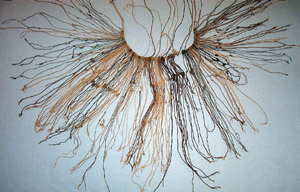American scientists unravel the mystery of Incan written language
Incas were using a peculiar written language in their everyday lives

American scientists believe that they are about to unravel the mystery of the khipus language, which ancient Incas used. The Inca civilization emerged on the territory of modern states of Chile and Columbia in 1200 A.D. The Inca Empire, centered on the Andean mountain range, was the most extensive in the Americas before being destroyed by Spanish conquistadors in 1532. To record information, the ancient Inca used enigmatic devices called khipus. The Spanish conquistadors destroyed most khipus they came across. Only about 700 khipus have been recovered, almost all from looted Inca tombs, National Geographic says. 
Historian Leland Locke proved in 1923 that Incas were using a peculiar written language in their everyday lives. The khipus were used throughout the reign of the empire. Earlier versions of the devices may have been used by pre-Inca people more than 500 years before the Spanish invasion. The Spaniards believed that the devices were used as decorations. Locke believed that the cords did not have only the decorative significance, but also represented an early form of ancient writing. The scientist, however, failed to declassify any of the 600 knotted cords, which he had at his disposal.
Made from cotton or animal hair, the objects consisted of multiple knotted strings hanging vertically from a single horizontal string. Gary Urton, a professor of pre-Columbian studies at Harvard University in Cambridge, Massachusetts, conducted a computer analysis of 21 khipu texts, which had been uncovered on the Peruvian coast. Urton concluded that the texts actually represented outtakes from the Incan accounting system. The specialist says the khipus that he analyzed, show how census and tribute data were assembled and transferred among different levels of authority within the Inca administrative system. The khipus on the lowest level of the hierarchy may have represented contact between the khipu keeper and local laborers.
According to Utron, khipu is the 7-bit code - the system, which makes specific signs on the base of peculiar knots and their combination on every cord. This principle is the basis of ASCII code, which allows to type characters with the help of a keyboard. ASCII is the 8-bit code: making combinations of 0 and 1 it produces 256 characters. The 7-bit system yields only 128 combinations. Gary Urton, however, is certain that the Incan code was a lot more progressive: different colors of the knots (up to 24 colors were used) could eventually result in 1,536 various units of information. It is noteworthy that Egyptian and Mayan hieroglyphs had the value of 700 or 800 units.
According to Urton, there are over 700 kinds of khipu, two-thirds of which are linked with numbers. "Here, we are actually seeing the communication of information within a set of khipus … where the sum of values is not on the khipu itself but on another khipu. It's a communication event embedded there in the knots and strings of the khipu," the scientist said.
Subscribe to Pravda.Ru Telegram channel, Facebook, RSS!

